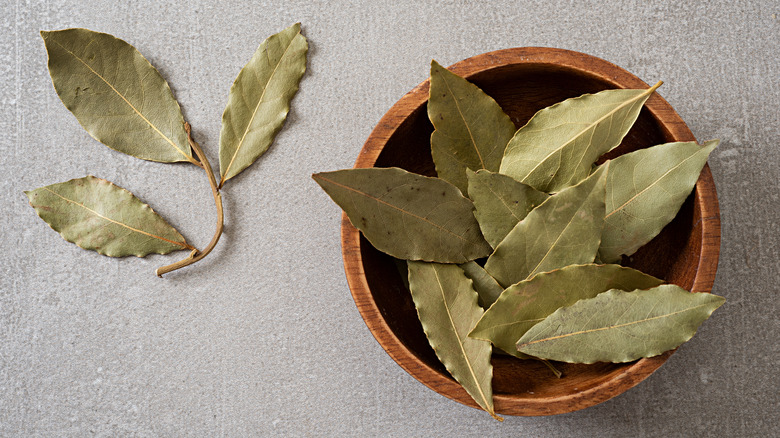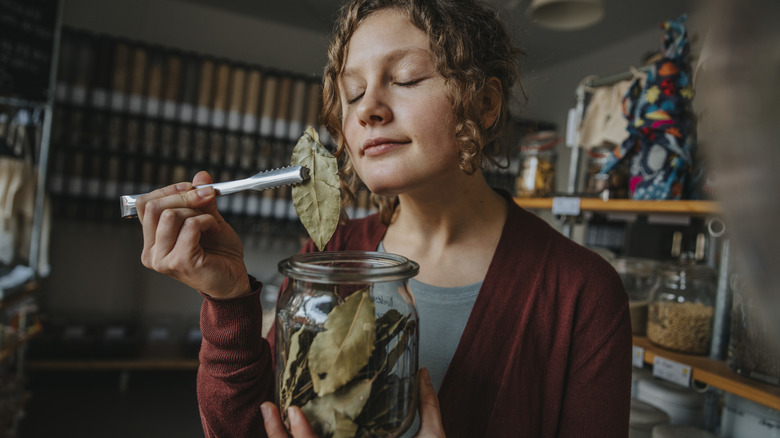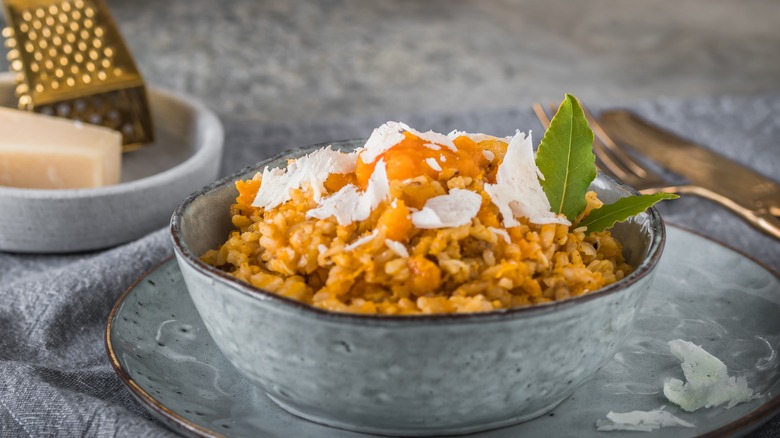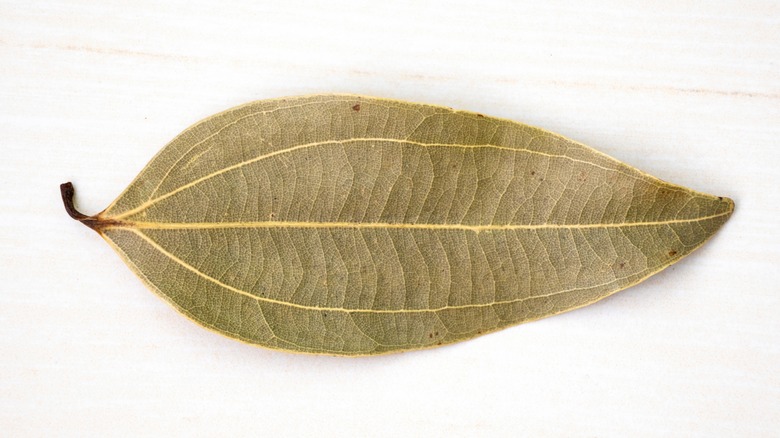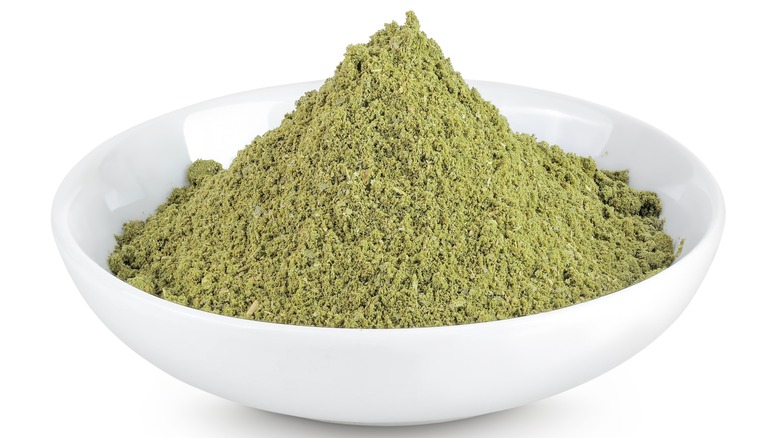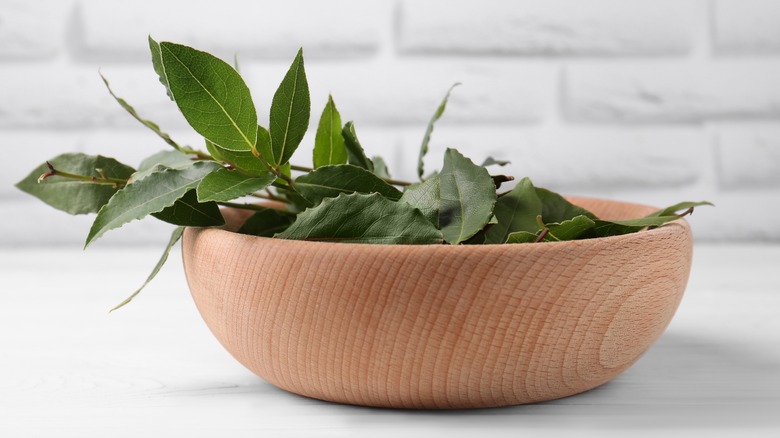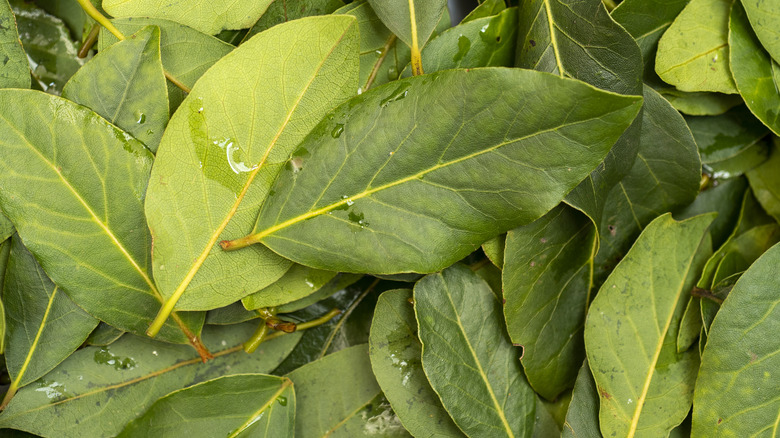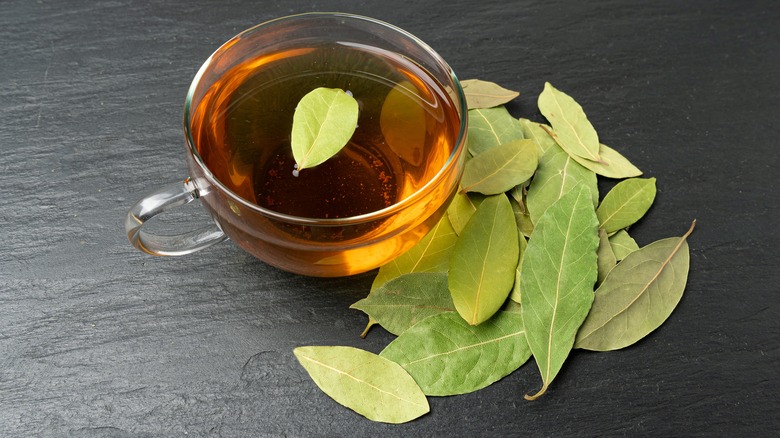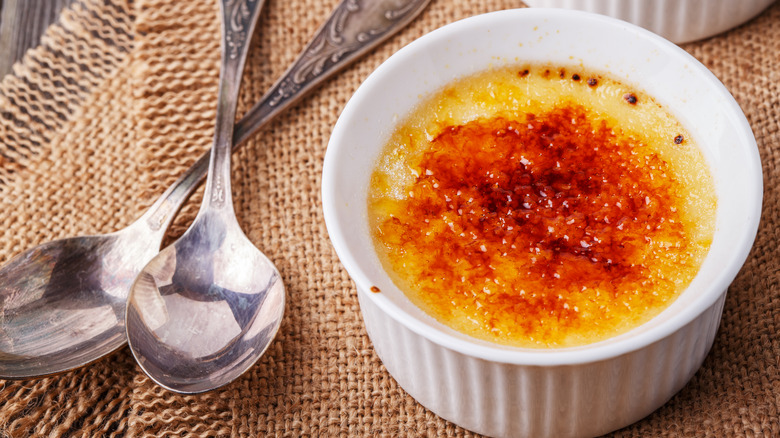9 False Facts About Bay Leaves You Probably Thought Were True
Sitting alongside the herbs and spices in most well-stocked supermarkets, you'll likely find bay leaves. These khaki green tree leaves have a rich, robust aroma reminiscent of cloves, thyme, allspice, and a hint of lemon. Or at least, that's what one variety of bay leaf smells like. For such an easy-to-find ingredient, there are a lot of misconceptions and misunderstandings about this fragrant herb.
Bay leaves, also known as laurel leaves, have a fascinatingly long and storied history. In the Mediterranean region, they've been cultivated since ancient times, finding their way into culture and medicine as well as cuisine. Famously, laurel wreaths were a symbol of victory in Ancient Rome, where they were worn by emperors — a tradition popularized by Julius Caesar who, according to his biographer, wore one to disguise his baldness.
In modern times, bay leaves no longer grace the heads of state leaders, and may not often end up on their dinner plates either. These aromatic leaves aren't really an essential ingredient in a lot of contemporary cooking, so if you're not sure how exactly to use them, then don't worry. You're not alone. Whether or not you know how to use bay leaves in your cooking, though, there are a few false facts out there. Let's clear some of them up.
1. False: They don't taste like much
If you've spent time in the culinary corners of the internet, you may have seen discussions started by people unsure if bay leaves add much to their cooking. Some even jokingly calling them a "hoax." It's no niche opinion either — even celebrity chef Ina Garten has admitted being unsure about bay leaves. However, while it's certainly true that the flavor they add can be subtle, it makes a definite difference.
Bay leaves can actually give a surprisingly strong flavor if you throw too many into your cooking. Used well though, many chefs value the distinctive richness they can bring. A study published in the International Journal of Gastronomy and Food Science quotes a few chefs like restaurateur Joey Baldino, who explains, "They give a depth of flavor that you can't get with any other herbs especially in fish dishes." Vegetable chef Rich Laudau calls them "irreplaceable in stocks" for the deep, savory taste they add, and chef and author Sohui Kim praises the bay leaf as "undetectable to eye or even to the taste buds" while giving "a real je ne sais quoi, umami punch." Quite an endorsement.
If all of this makes you curious to see for yourself, a good place to start would be to use bay leaves in dishes with milder flavors, to make their taste more apparent. Something like this recipe for decadently creamy ravioli flavored with sage and bay leaf might be a good option to try.
2. False: Bay leaves are only used in Mediterranean cuisine
For many people, bay leaves will call to mind the vibrant flavors and idyllic scenery of the Mediterranean. This association is well earned. Bay leaves hold a cherished place in culinary traditions all around the Mediterranean sea. Cuisines across the region come from a diverse collection of cultures, but share rich and wholesome umami notes, with sweet tomatoes and beautifully fragrant herbs, and bay leaves are often an essential ingredient. Their distinctly savory taste can be found in cuisines from comforting Italian risotto to hearty Moroccan lamb tagine to indulgently spiced Egyptian fatta. But bay leaves are also added to cooking pots all around the world.
Browse enough recipes and you'll likely see bay leaves on the ingredients lists in plenty of places very far from the Mediterranean. They're an important ingredient in Indian dishes like aromatic jeera rice, where they're used together with characteristically South Asian spices like cumin seeds and green cardamom. They're also an important ingredient in Mexican cooking, which gains its distinctive charm from bright-tasting herbs, blending with the heavy taste of spices and light, sharp citrus. With these cuisines having very different flavor profiles, it may be a little surprising that they all contain bay leaves. As it happens, this leads on to another common misconception about this herb — or, more accurately, these herbs...
3. False: All bay leaves taste the same
Confusingly, there are several types of bay leaf out there, and they all come from different species of tree! The type commonly found in the cuisines of Europe and North America is bay laurel. This is the Mediterranean variety, sometimes known as the Turkish bay leaf. Three other types of bay leaf, the California bay leaf, Mexican bay leaf, and Indian bay leaf, come from trees that are distant cousins of Mediterranean bay trees. There are also two more, the West Indian bay leaf and the Indonesian bay leaf, which come from an entirely different plant family that is more closely related to clove, allspice, and eucalyptus.
While all of these may be known as bay leaves in English, they have drastically different flavor profiles; so much so that they can't really be used interchangeably. Indian bay leaves, for example, have a taste and aroma more similar to clove or cinnamon than their Mediterranean counterparts, meaning that trying to swap out one type of leaf for the other will give a dish with a noticeably different flavor. California bay leaves, meanwhile, have a stronger, more eucalyptus-like flavor that some people describe as "medicinal" when used in cooking. All of this means that if a recipe calls for bay leaves, it's a good idea to pay attention to the recipe's origin, just to make sure you're using the right type of leaf.
4. False: They must always be used whole
Anyone familiar with them will know that bay leaves are always cooked whole, and then removed when the dish is served. Or are they? This is certainly the most common way to use these leaves in your cooking, but it isn't the only one.
Bay leaves can also be found on sale ground up into a fine powder, similar to the other spices you probably keep in your kitchen. If you're planning on using powdered bay leaves, though, you need to be rather careful. If you're familiar with the mild taste given by adding a bay leaf into your cooking pot, you may be unprepared for exactly how strong-tasting powdered bay leaves can be. If you're too heavy handed, you can easily end up with a flavor so overpowering that your dish becomes virtually inedible. Better to treat powdered bay leaf a bit like salt — try using just a pinch at first and then taste to see whether you actually need any more.
Ground bay leaves aren't quite as easy to find as whole ones, so you may need to spend some time looking around before you find any, and you may need to try more specialist suppliers. There's another thing to be careful of when buying: You should ideally look for leaves that have been finely powdered. Bay leaves are tough and chewy, so pieces of leaf that are too large can easily add some unpleasant texture into your dish.
5. False: Fresh and dried bay leaves taste the same
Mediterranean bay leaves thrive in climates too arid for many other plants to survive. Tough and oily, they retain a lot of flavor when dried. A lot, but not all. Even so, kitchens that typically favor fresh herbs will often use bay leaves in dried form instead. One big reason is that the flavor of fresh bay leaves can easily be too much. While dried bay leaves have a mellow, herbal flavor, the fresh ones taste much stronger, with a sharper scent and more bitterness in their taste.
If you have the chance to use fresh bay leaves in your cooking, you'll certainly notice how much more potent they are, making it quite easy to accidentally give your cooking an overpoweringly strong flavor. Fresh bay leaves may be hard to find on sale, but one option is to grow your own. Bay trees aren't difficult to keep, and make good houseplants.
Bay leaves lose some of their potency when they're dried, but they'll also keep on losing flavor over time. The longer they sit on the shelf, the more their original taste will fade — so while bay leaves can have a shelf life of up to three years, you might not realize exactly how weak they've become. It's worth keeping in mind, too, that you likely don't know how long your dried bay leaves were sitting in storage before arriving in your kitchen.
6. False: Bay leaves are toxic if eaten
It's a fairly common myth that you shouldn't eat bay leaves because they're poisonous if you do. They're not. While there are a couple of very similar trees with lookalike leaves that actually are poisonous, like mountain laurel, these are unlikely to end up in your kitchen. However, while you can technically eat bay leaves, you shouldn't. They won't poison you, but they can still be harmful.
Bay leaves are tough and leathery. Trying to chew on one can be unpleasant, and if you try to swallow one, it can be a choking hazard. Even worse, the leaves and stems have sharp edges, meaning that swallowing one can potentially lead to internal injuries. There are medical reports of patients who went to hospital with abdominal pains and ended up having bay leaf stems removed from their digestive tracts. Ouch!
If you're using whole bay leaves in your cooking, the best option is to remove them from your food before eating, and if you want to be on the safe side, you can even remove the leaves before they find their way onto anyone's dinner plate. The easiest way to do this to use a French herb mix called a bouquet garni. This is a bundle of herbs, tightly tied with string. It can be placed into a cooking pot to infuse flavor while being easy to remove. As well as bay leaves, this can be helpful for other tough, woody herbs like rosemary.
7. False: They're only for food
Bay leaves are most familiar as an ingredient in foods, particularly soups and stews where the time spent simmering lets them infuse their flavor more fully. But that's not the only place they can be used — bay leaves can also be brewed into tea. As with many herbal teas, you're likely to see a variety of claimed health benefits touted online, but in the case of bay leaves, there's truth behind at least some of these.
Bay leaves have traditionally been used as medicine, and modern researchers have found that they do have antibacterial and antiviral properties, as well as some anti-inflammatory effects. Bay leaf tea can also act as a digestive aid, helping to soothe an upset stomach. When buying a bag of dried bay leaves, it's not unusual to find a collection of broken leaf fragments at the bottom, and brewing them into tea can be a helpful way to use them all up.
Other types of bay leaf can also be brewed into tea, with the West Indian variety working particularly well. These leaves have a different flavor profile, lacking the citrussy, pine-like flavors of Mediterranean bay leaves, and instead having flavors reminiscent of cinnamon, cardamom, and vanilla. With their warm and mildly spicy taste, they're an ingredient in sorrel, a Caribbean drink made from hibiscus flowers with spices and brown sugar, that's usually enjoyed during the holiday season.
8. False: Ancient Greek athletes wore laurel wreaths
In Ancient Greece, bay leaves held great significance. One popular Ancient Greek staple was lentil soup, known as fakes. The same soup is still made today, essentially unchanged, and the recipe includes a large bay leaf. It's essential for getting the flavor just right. Bay leaves were more than just food in Ancient Greece though. They were a big part of culture too.
In the original Olympic games, rather than being awarded medals, winning athletes were given victory wreaths to wear. While we tend to imagine people in the ancient world wearing laurel wreaths, Olympians were never given laurels. Instead, athletes were given olive wreaths to wear — specifically made from a branch of the olive tree growing behind the temple of Zeus. A kingly prize, especially considering that olives and their oil were also vitally important in the ancient world.
While Olympians may not have worn laurel wreaths in Ancient Greece though, the winners of a different set of games did. The Greeks held several different competitions, one of which was the Pythian games. Rather than athletics, the Pythian games began as a competition between musicians. In this ancient musical battle, winners were awarded wreaths made of laurel, a tree sacred to the god Apollo, the patron god of poets. Laurel wreaths were a mark of the winner's poetic ability, and traces of this old tradition can still be found in modern times with the term "poet laureate."
9. False: They're only for savory dishes
Bay leaves are used most often in savory dishes, where they truly shine by adding depth and nuance to dishes. But this isn't the only place they can be used. The fragrance of Mediterranean bay leaves contains a variety of aromatic compounds which give notes of clove, citrus, and licorice — all of which can go very nicely in dessert dishes.
While it may seem strange at first, to use bay leaves in sweet recipes, they can work extremely well. The sharp taste of bay leaf goes particularly nicely with creamy, buttery recipes. Infusing bay leaves into the cream used to make crème brûlée or panna cotta can give a distinctive twist to these classic desserts. Including a little powdered bay leaf in a shortbread recipe will add a hint of spice that works especially well if you top the shortbread with lemon icing. If this piques your interest and you want to bake a luxurious and distinctive dessert, either to impress guests or to bring to a potluck party, why not try our recipe for a pear upside-down cake with a sumptuous bay leaf glaze? You'll be a convert to the idea of using bay leaves in your desserts in no time!
